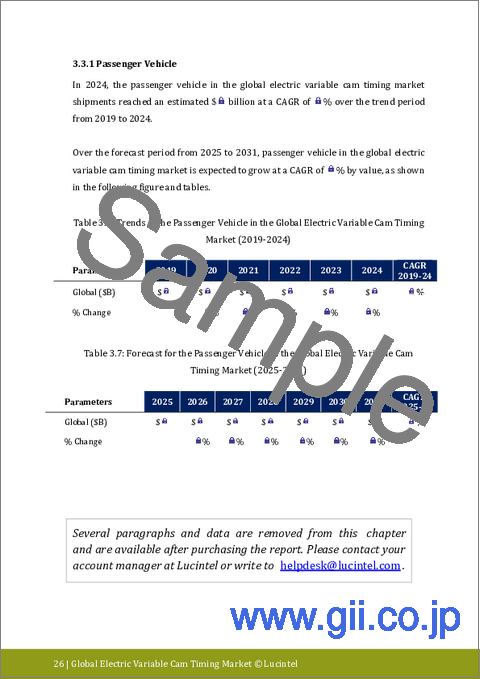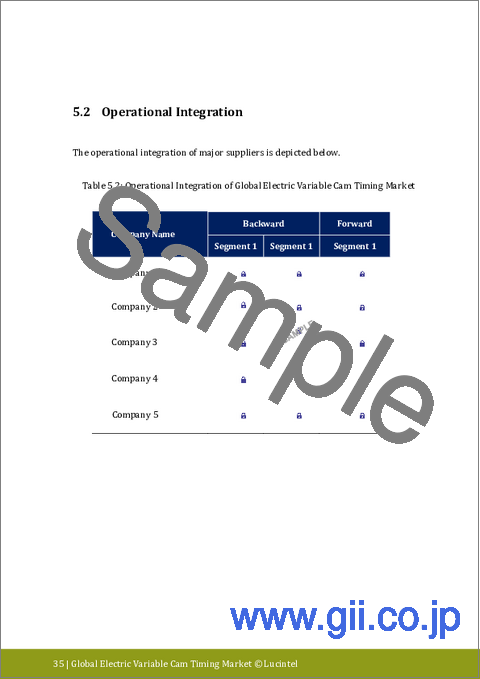|
|
市場調査レポート
商品コード
1603605
電動式可変カムタイミング市場レポート:動向、予測、競合分析 (2030年まで)Electric Variable Cam Timing Market Report: Trends, Forecast and Competitive Analysis to 2030 |
||||||
カスタマイズ可能
適宜更新あり
|
|||||||
| 電動式可変カムタイミング市場レポート:動向、予測、競合分析 (2030年まで) |
|
出版日: 2024年11月25日
発行: Lucintel
ページ情報: 英文 150 Pages
納期: 3営業日
|
全表示
- 概要
- 目次
電動式可変カムタイミングの動向と予測
電動式可変カムタイミング世界市場の将来は、乗用車市場と商用車市場における機会で有望視されています。世界の電動式可変カムタイミング市場は、2024年から2030年にかけてCAGR 7.8%で成長すると予測されます。この市場の主な促進要因は、エンジン効率と性能の向上への注目が高まっていることであり、バルブタイミングを正確に制御することで燃焼を最適化し、燃費の改善、排出ガスの削減、エンジン出力の向上を実現します。
- Lucintelの予測では、用途別ではシングル可変が予測期間中に高い成長を遂げる見込みです。
- 用途別では、乗用車が高い成長が見込まれます。
- 地域別では、北米が予測期間で最も高い成長が見込まれます。
電動式可変カムタイミング市場の戦略的成長機会
電動式可変カムタイミング市場における主要な戦略的機会には、以下のようなものがある:
- 先端材料への投資:先端材料への投資:VCTシステム用の先端材料の研究開発に投資することで、耐久性と性能を向上させ、成長を促進することができます。高強度合金と耐熱性ポリマーは信頼性と寿命を向上させ、プレミアム製品の提供と市場における差別化の機会を創出します。
- 新興市場への進出:インドや中国など、自動車部門が成長している新興市場をターゲットにすることは、大きな成長機会となります。これらの地域に合わせたコスト効率の高い高性能VCTシステムを開発することで、市場シェアを獲得し、効率的なエンジン技術に対する需要の高まりに対応することができます。
- ハイブリッド車および電気自動車との統合:ハイブリッド車や電気自動車専用に設計されたVCTシステムを開発することは、自動車産業が電動化へとシフトする中で戦略的な機会を提供します。これらのシステムは、ハイブリッドパワートレインの性能と効率を高め、よりクリーンで効率的な自動車への移行をサポートすることができます。
- モジュラー設計と適応設計の重視:モジュール式で適応性の高いVCT設計を重視することで、さまざまなエンジンアーキテクチャに対応する柔軟性と拡張性を提供することができます。モジュラーシステムにより、メーカーはさまざまな車種やエンジンタイプに迅速に対応できるため、開発コストを削減し、市場投入までの時間を短縮することができます。
結論として、戦略的成長機会には、先端材料への投資、新興市場への進出、ハイブリッド車や電気自動車との統合、モジュール設計への注力などがあり、これらすべてが電動VCT分野の技術革新と市場拡大を促進することができます。
電動式可変カムタイミング市場の市場促進要因・課題
電動式可変カムタイミング市場は、様々な技術的、経済的、規制的要因の影響を受けています。これらの市場促進要因・課題を理解することは、このニッチ市場をナビゲートし、成長機会を活用する上で極めて重要です。
促進要因
- 技術の進歩:センサーや制御システムの改良など、VCT技術における継続的な技術革新が市場成長の原動力となっています。技術の進歩はVCTシステムの精度と効率を高め、エンジン性能と燃費の向上に貢献します。
- 燃料効率に対する需要の高まり:低燃費車に対する消費者と規制当局からのプレッシャーの高まりが、先進VCTシステムの需要を押し上げています。VCT技術は、エンジン性能と燃料燃焼の最適化に役立ち、燃費改善と排出ガス削減の動向に合致します。
- ハイブリッド車と電気自動車の拡大:ハイブリッド車と電気自動車の増加は、VCTシステムの成長機会をもたらします。自動車メーカーがハイブリッド車や電気自動車のパワートレインを開発するのに伴い、これらの先進パワートレインのエンジン性能を最適化できるVCTシステムのニーズが高まっています。
- 規制要件:排出ガス規制と燃費規制の強化が、VCTシステムの採用を後押ししています。規制基準の遵守には、エンジン効率を向上させ、排出ガスを削減する先進技術が必要であり、VCTソリューションの需要を押し上げています。
課題:
- 高い製造コスト:先進VCTシステムの開発と製造には、材料、技術、製造工程に関連する多大なコストがかかります。製造コストの高騰は、価格設定や市場競争に影響する可能性があり、メーカーにとって課題となります。
- 複雑な統合要件:VCTシステムと先進的なエンジン管理システムの統合は複雑で、専門知識を必要とします。互換性とシームレスな動作を確保することは、メーカーにとって技術的課題となります。
- サプライチェーンの混乱:高強度合金や先端ポリマーなどの原材料の入手可能性やコストの変動は、生産や価格設定に影響を与える可能性があります。サプライチェーンの混乱は、コスト増と潜在的な遅れにつながる可能性があります。
- 激しい市場競争:VCT市場は競争が激しく、多数のメーカーがさまざまな製品を提供しています。激しい競争は価格設定や利益率に影響を与える可能性があり、各社は競争力を維持するために製品を革新し差別化する必要があります。
まとめると、技術の進歩、燃費効率に対する需要、ハイブリッド車の拡大、規制要件が市場成長の原動力となる一方で、高い生産コスト、複雑な統合、サプライチェーンの混乱、競争が大きな課題となります。
目次
第1章 エグゼクティブサマリー
第2章 世界の電動式可変カムタイミング市場:市場力学
- イントロダクション、背景、分類
- サプライチェーン
- 業界の促進要因と課題
第3章 市場動向と予測分析 (2018年~2030年)
- マクロ経済動向 (2018~2023年) と予測 (2024~2030年)
- 世界の電動式可変カムタイミング市場の動向 (2018~2023年) と予測 (2024~2030年)
- 世界の電動式可変カムタイミング市場:種類別
- シングル可変
- ダブル可変
- 世界の電動式可変カムタイミング市場:用途別
- 乗用車
- 商用車
第4章 地域別の市場動向と予測分析 (2018年~2030年)
- 世界の電動式可変カムタイミング市場:地域別
- 北米の電動式可変カムタイミング市場
- 欧州の電動式可変カムタイミング市場
- アジア太平洋の電動式可変カムタイミング市場
- その他地域の電動式可変カムタイミング市場
第5章 競合分析
- 製品ポートフォリオ分析
- 運用統合
- ポーターのファイブフォース分析
第6章 成長機会と戦略分析
- 成長機会分析
- 世界の電動式可変カムタイミング市場の成長機会:種類別
- 世界の電動式可変カムタイミング市場の成長機会:用途別
- 世界の電動式可変カムタイミング市場の成長機会:地域別
- 世界の電動式可変カムタイミング市場の新たな動向
- 戦略的分析
- 新製品の開発
- 世界の電動式可変カムタイミング市場の生産能力拡大
- 世界の電動式可変カムタイミング市場における企業合併・買収 (M&A)、合弁事業
- 認証とライセンシング
第7章 主要企業のプロファイル
- Denso
- Delphi
- Hitachi Automotive Systems
- Bosch
- Valeo
- Aisin
- BorgWarner
Electric Variable Cam Timing Trends and Forecast
The future of the global electric variable cam timing market looks promising with opportunities in the passenger car and commercial vehicle markets. The global electric variable cam timing market is expected to grow with a CAGR of 7.8% from 2024 to 2030. The major drivers for this market are the increasing focus on enhancing engine efficiency and performance and it allows for precise control of valve timing, optimizing combustion for improved fuel efficiency, reduced emissions, and enhanced engine power.
- Lucintel forecasts that, within the type category, a single variable is expected to witness higher growth over the forecast period.
- Within the application category, passenger cars are expected to witness a higher growth.
- In terms of regions, North America is expected to witness the highest growth over the forecast period.
Gain valuable insights for your business decisions with our comprehensive 150+ page report.
Emerging Trends in the Electric Variable Cam Timing Market
Emerging trends in the electric variable cam timing market are reshaping its future applications and dynamics:
- Integration with Advanced Engine Management Systems: The trend towards integrating VCT systems with sophisticated engine management systems is growing. This integration enhances real-time adjustments to cam timing, improving engine performance and fuel efficiency. Advanced algorithms and sensors enable more precise control, leading to better overall engine responsiveness and emissions reduction.
- Focus on Electrification and Hybrid Vehicles: There is increasing emphasis on developing VCT systems that are compatible with hybrid and electric powertrains. These systems are designed to optimize engine performance in combination with electric motors, contributing to improved fuel efficiency and lower emissions. This trend supports the automotive industry's shift towards electrification.
- Miniaturization and Compact Designs: The development of smaller and more compact VCT systems is gaining traction. Miniaturization allows for integration into more compact engine designs, contributing to weight reduction and improved space utilization. Compact VCT systems also help meet the demand for more efficient and lightweight engine components.
- Enhanced Materials and Durability: The use of advanced materials to improve the durability and performance of VCT systems is a growing trend. Innovations in materials science are leading to the development of components that can withstand higher temperatures and stresses, resulting in longer-lasting and more reliable VCT systems.
- Growth in Aftermarket Solutions: The aftermarket sector is seeing increased demand for performance-enhancing VCT systems. Enthusiasts and performance-oriented drivers are seeking advanced VCT solutions to boost engine output and efficiency.
In conclusion, these trends highlight advancements in engine management integration, electrification compatibility, miniaturization, and material enhancements, driving innovation and efficiency in the electric VCT market.
Recent Developments in the Electric Variable Cam Timing Market
Ongoing innovations and advancements in the electric variable cam timing market have been highlighted:
- Advanced Sensor Integration: Recent developments have seen the integration of sophisticated sensors within electric VCT systems to enhance precision and responsiveness. These sensors provide real-time feedback on engine conditions, allowing for more accurate adjustments to cam timing. This improvement leads to better engine performance, fuel efficiency, and emissions control. Advanced sensor technology also supports the development of adaptive VCT systems that can optimize engine performance under various operating conditions.
- Enhanced Materials for Durability: Manufacturers are increasingly using advanced materials such as high-strength alloys and heat-resistant polymers to improve the durability of VCT systems. These materials enhance the ability of VCT components to withstand high temperatures and mechanical stresses, resulting in longer service life and reduced maintenance needs. Innovations in materials science are driving improvements in both performance and reliability of electric VCT systems.
- Modular VCT Systems: The development of modular electric VCT systems is a key trend, allowing for greater flexibility and ease of integration into various engine architectures. Modular designs enable manufacturers to adapt VCT systems to different engine sizes and types, reducing development costs and time. This approach also supports customization and scalability, catering to a wide range of automotive applications.
- Focus on Hybrid and Electric Vehicles: There is a growing focus on developing electric VCT systems specifically for hybrid and electric vehicles. These systems are designed to work seamlessly with electric motors and optimize engine performance in conjunction with hybrid powertrains. The integration of VCT technology in hybrid vehicles helps improve fuel efficiency and reduce emissions, aligning with the automotive industry's shift towards electrification.
In summary, recent developments emphasize advancements in sensor integration, durable materials, modular designs, and compatibility with hybrid and electric vehicles, all contributing to the evolution of electric VCT technology.
Strategic Growth Opportunities for Electric Variable Cam Timing Market
Some key strategic opportunities in the electric variable cam timing market include:
- Investment in Advanced Materials: Investing in research and development of advanced materials for VCT systems can drive growth by improving durability and performance. High-strength alloys and heat-resistant polymers offer enhanced reliability and longevity, creating opportunities for premium product offerings and differentiation in the market.
- Expansion into Emerging Markets: Targeting emerging markets with growing automotive sectors, such as India and China, presents significant growth opportunities. Developing cost-effective and high-performance VCT systems tailored to these regions can capture market share and address the increasing demand for efficient engine technologies.
- Integration with Hybrid and Electric Vehicles: Developing VCT systems specifically designed for hybrid and electric vehicles offers a strategic opportunity as the automotive industry shifts towards electrification. These systems can enhance the performance and efficiency of hybrid powertrains, supporting the transition to cleaner and more efficient vehicles.
- Focus on Modular and Adaptable Designs: Emphasizing modular and adaptable VCT designs can provide flexibility and scalability for various engine architectures. Modular systems enable manufacturers to quickly adapt to different vehicle models and engine types, reducing development costs and accelerating time-to-market.
In conclusion, strategic growth opportunities include investing in advanced materials, expanding into emerging markets, integrating with hybrid and electric vehicles, and focusing on modular designs, all of which can drive innovation and market expansion in the electric VCT sector.
Electric Variable Cam Timing Market Driver and Challenges
The electric variable cam timing market is influenced by various technological, economic, and regulatory factors. Understanding these drivers and challenges is crucial for navigating this niche market and leveraging growth opportunities.
Drivers:
- Technological Advancements: Ongoing innovations in VCT technology, including improved sensors and control systems, drive market growth. Advances in technology enhance the precision and efficiency of VCT systems, contributing to better engine performance and fuel economy.
- Increasing Demand for Fuel Efficiency: Growing consumer and regulatory pressures for fuel-efficient vehicles boost the demand for advanced VCT systems. VCT technology helps optimize engine performance and fuel combustion, aligning with the trend toward improved fuel efficiency and reduced emissions.
- Expansion of Hybrid and Electric Vehicles: The rise in hybrid and electric vehicles presents growth opportunities for VCT systems. As automotive manufacturers develop more hybrid and electric powertrains, there is a need for VCT systems that can optimize engine performance in these advanced powertrains.
- Regulatory Requirements: Stricter emissions and fuel efficiency regulations drive the adoption of VCT systems. Compliance with regulatory standards requires advanced technologies that improve engine efficiency and reduce emissions, boosting demand for VCT solutions.
Challenges:
- High Production Costs: The development and manufacturing of advanced VCT systems involve significant costs related to materials, technology, and production processes. High production costs can impact pricing and market competitiveness, posing a challenge for manufacturers.
- Complex Integration Requirements: Integrating VCT systems with advanced engine management systems can be complex and require specialized expertise. Ensuring compatibility and seamless operation poses technical challenges for manufacturers.
- Supply Chain Disruptions: Fluctuations in the availability and cost of raw materials, such as high-strength alloys and advanced polymers, can affect production and pricing. Supply chain disruptions can lead to increased costs and potential delays.
- Intense Market Competition: The VCT market is highly competitive, with numerous manufacturers offering a range of products. Intense competition can impact pricing and profit margins, requiring companies to innovate and differentiate their products to remain competitive.
In summary, technological advancements, demand for fuel efficiency, expansion of hybrid vehicles, and regulatory requirements drive market growth, while high production costs, complex integration, supply chain disruptions, and competition present significant challenges.
List of Electric Variable Cam Timing Companies
Companies in the market compete on the basis of product quality offered. Major players in this market focus on expanding their manufacturing facilities, R&D investments, infrastructural development, and leverage integration opportunities across the value chain. With these strategies electric variable cam timing companies cater increasing demand, ensure competitive effectiveness, develop innovative products & technologies, reduce production costs, and expand their customer base. Some of the electric variable cam timing companies profiled in this report include-
- Denso
- Delphi
- Hitachi Automotive Systems
- Bosch
- Valeo
- Aisin
- Borgwarner
Electric Variable Cam Timing by Segment
The study includes a forecast for the global electric variable cam timing by type, application, and region.
Electric Variable Cam Timing Market by Type [Analysis by Value from 2018 to 2030]:
- Single Variable
- Double Variable
Electric Variable Cam Timing Market by Application [Analysis by Value from 2018 to 2030]:
- Passenger Vehicles
- Commercial Vehicles
Electric Variable Cam Timing Market by Region [Shipment Analysis by Value from 2018 to 2030]:
- North America
- Europe
- Asia Pacific
- The Rest of the World
Country Wise Outlook for the Electric Variable Cam Timing Market
Major players in the market are expanding their operations and forming strategic partnerships to strengthen their positions. Below are the recent developments by major electric variable cam timing producers in key regions: the USA, China, India, Japan, and Germany:
- United States: Recent advancements in the U.S. electric VCT market include the integration of advanced sensor technologies and electronic controls to improve precision and responsiveness. Manufacturers are focusing on enhancing the efficiency of VCT systems to meet stricter emissions regulations and improve fuel economy. Additionally, there is a trend toward developing modular VCT systems that can be easily adapted for various engine architectures.
- China: In China, the electric VCT market is rapidly growing with a focus on cost-effective solutions and large-scale production. Chinese manufacturers are investing in new technologies to enhance the performance of VCT systems while maintaining affordability. There is also a push toward developing VCT systems for both traditional and hybrid vehicles, supporting the country's expanding automotive sector.
- Germany: Germany has seen significant advancements in electric VCT technology, emphasizing precision engineering and integration with advanced engine management systems. German companies are developing VCT systems that offer improved performance and efficiency, leveraging their expertise in automotive engineering. Innovations include enhanced thermal management and increased adaptability to different engine types.
- India: In India, the electric VCT market is experiencing growth driven by increasing vehicle production and demand for improved engine efficiency. Recent developments include the introduction of cost-effective VCT systems tailored for the Indian automotive market. Manufacturers are focusing on enhancing reliability and performance while addressing the needs of both domestic and export markets.
- Japan: Japan is at the forefront of innovation in electric VCT systems, with advancements in miniaturization and integration with hybrid powertrains. Japanese manufacturers are developing compact VCT systems that provide precise control and enhance fuel efficiency. The focus is also on reducing production costs while maintaining high performance and durability in VCT systems.
Features of the Global Electric Variable Cam Timing Market
Market Size Estimates: Electric variable cam timing market size estimation in terms of value ($B).
Trend and Forecast Analysis: Market trends (2018 to 2023) and forecast (2024 to 2030) by various segments and regions.
Segmentation Analysis: Electric variable cam timing market size by type, application, and region in terms of value ($B).
Regional Analysis: Electric variable cam timing market breakdown by North America, Europe, Asia Pacific, and Rest of the World.
Growth Opportunities: Analysis of growth opportunities in different type, application, and regions for the electric variable cam timing market.
Strategic Analysis: This includes M&A, new product development, and competitive landscape of the electric variable cam timing market.
Analysis of competitive intensity of the industry based on Porter's Five Forces model.
If you are looking to expand your business in this or adjacent markets, then contact us. We have done hundreds of strategic consulting projects in market entry, opportunity screening, due diligence, supply chain analysis, M & A, and more.
This report answers following 11 key questions:
- Q.1. What are some of the most promising, high-growth opportunities for the electric variable cam timing market by type (single variable and double variable), application (passenger vehicles and commercial vehicles), and region (North America, Europe, Asia Pacific, and the Rest of the World)?
- Q.2. Which segments will grow at a faster pace and why?
- Q.3. Which region will grow at a faster pace and why?
- Q.4. What are the key factors affecting market dynamics? What are the key challenges and business risks in this market?
- Q.5. What are the business risks and competitive threats in this market?
- Q.6. What are the emerging trends in this market and the reasons behind them?
- Q.7. What are some of the changing demands of customers in the market?
- Q.8. What are the new developments in the market? Which companies are leading these developments?
- Q.9. Who are the major players in this market? What strategic initiatives are key players pursuing for business growth?
- Q.10. What are some of the competing products in this market and how big of a threat do they pose for loss of market share by material or product substitution?
- Q.11. What M&A activity has occurred in the last 5 years and what has its impact been on the industry?
Table of Contents
1. Executive Summary
2. Global Electric Variable Cam Timing Market : Market Dynamics
- 2.1: Introduction, Background, and Classifications
- 2.2: Supply Chain
- 2.3: Industry Drivers and Challenges
3. Market Trends and Forecast Analysis from 2018 to 2030
- 3.1. Macroeconomic Trends (2018-2023) and Forecast (2024-2030)
- 3.2. Global Electric Variable Cam Timing Market Trends (2018-2023) and Forecast (2024-2030)
- 3.3: Global Electric Variable Cam Timing Market by Type
- 3.3.1: Single Variable
- 3.3.2: Double Variable
- 3.4: Global Electric Variable Cam Timing Market by Application
- 3.4.1: Passenger Vehicles
- 3.4.2: Commercial Vehicles
4. Market Trends and Forecast Analysis by Region from 2018 to 2030
- 4.1: Global Electric Variable Cam Timing Market by Region
- 4.2: North American Electric Variable Cam Timing Market
- 4.2.1: North American Market by Type: Single Variable and Double Variable
- 4.2.2: North American Market by Application: Passenger Vehicles and Commercial Vehicles
- 4.3: European Electric Variable Cam Timing Market
- 4.3.1: European Market by Type: Single Variable and Double Variable
- 4.3.2: European Market by Application: Passenger Vehicles and Commercial Vehicles
- 4.4: APAC Electric Variable Cam Timing Market
- 4.4.1: APAC Market by Type: Single Variable and Double Variable
- 4.4.2: APAC Market by Application: Passenger Vehicles and Commercial Vehicles
- 4.5: ROW Electric Variable Cam Timing Market
- 4.5.1: ROW Market by Type: Single Variable and Double Variable
- 4.5.2: ROW Market by Application: Passenger Vehicles and Commercial Vehicles
5. Competitor Analysis
- 5.1: Product Portfolio Analysis
- 5.2: Operational Integration
- 5.3: Porter's Five Forces Analysis
6. Growth Opportunities and Strategic Analysis
- 6.1: Growth Opportunity Analysis
- 6.1.1: Growth Opportunities for the Global Electric Variable Cam Timing Market by Type
- 6.1.2: Growth Opportunities for the Global Electric Variable Cam Timing Market by Application
- 6.1.3: Growth Opportunities for the Global Electric Variable Cam Timing Market by Region
- 6.2: Emerging Trends in the Global Electric Variable Cam Timing Market
- 6.3: Strategic Analysis
- 6.3.1: New Product Development
- 6.3.2: Capacity Expansion of the Global Electric Variable Cam Timing Market
- 6.3.3: Mergers, Acquisitions, and Joint Ventures in the Global Electric Variable Cam Timing Market
- 6.3.4: Certification and Licensing
7. Company Profiles of Leading Players
- 7.1: Denso
- 7.2: Delphi
- 7.3: Hitachi Automotive Systems
- 7.4: Bosch
- 7.5: Valeo
- 7.6: Aisin
- 7.7: BorgWarner





